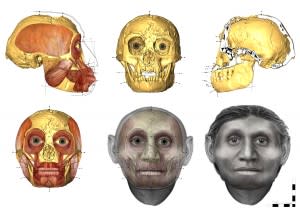Reconstructed Face of Extinct Hobbit Species Is Startlingly Humanlike
Once upon a time a tiny human species with large feet shared the planet with our own kind. It hunted giant rats and miniature cousins of the elephant, defended its kills from monstrous storks and dodged fearsome dragons. This is not the plot of a lost Tolkien book. This really happened. I'm referring, of course, to our extinct relative Homo floresiensis, which lived on the island of Flores in Indonesia as recently as 17,000 years ago and has for obvious reasons been dubbed the hobbit. It turns out that despite the species' small size, it may have looked rather familiar, according to a scientific reconstruction.
The Flores hobbit is known best from a relatively complete skeleton of an adult female known as LB1 who stood roughly a meter tall and possessed a brain less than a third of the size of our own. Her proportions are completely out of whack with what scientists expected to see in a human species that lived so recently in the grand scheme of things and instead call to mind much earlier human precursors such as Lucy's species, Australopithecus afarensis, which lived more than three million years ago. Thus experts have been debating the hobbits' place in the family tree ever since the bones were unveiled in 2004.
One intriguing theory holds that the hobbits may indicate that human ancestors left Africa far earlier than previously supposed. Conventional wisdom holds that the australopithecines never made it out of the mother land, leaving it to taller, larger-brained Homo to colonize the rest of the old world. But maybe, some researchers have suggested, the hobbits were a remnant population of australopithecine that made it out of Africa early on. That would help explain the creature's short stature and small brain, among other primitive features.
Such an explanation makes the new reconstruction of LB1's face all the more surprising to my inexpert eye. Anthropologist Susan Hayes of the University of Wollongong in Australia created the image using forensic techniques for estimating facial appearance from skull form. It looks a lot like a modern human to me, though I'm sure the tiny size of the head would detract from the resemblance in real life. Hayes revealed the reconstruction on December 10 at the annual Australian Archaeological Conference in Wollongong.
An alternate theory holds that the hobbits are dwarfed descendants of Homo erectus who evolved their small size as an adaptive response to the limited food resources available on Flores. Such "island dwarfing" has occurred in other species. A third possibility, embraced by a few researchers, is that the tiny bones are simply the remains of diseased modern humans.
Follow Scientific American on Twitter @SciAm and @SciamBlogs. Visit ScientificAmerican.com for the latest in science, health and technology news.
© 2012 ScientificAmerican.com. All rights reserved.




